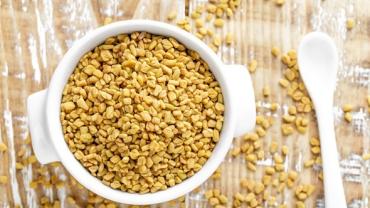
In the midst of a growing global trend of dysfunctional glucose regulation practitioners patients researchers and health advocates are enthusiastically attempting to find safe and natural alternatives to manage and curtail the unfortunate outcomes of blood sugar conditions. Pre-diabetes diabetes metabolic syndrome and others are no longer occasional occurrences in the practitioner’s office but rather their presence is the new norm and represents a complicated and deranged metabolic system in a vast majority of the population.
Many botanicals are being studied for their therapeutic effects on glucose and insulin management and the demand for a comprehensive approach continues to grow.
Fenugreek (Trigonella foenum graecum)
A significant amount of research advocates the therapeutic benefits of fenugreek seeds in glucose modulation specifically its efficacy in lowering fasting and postprandial glucose levels. Both fiber and saponins have been identified as the main players in fenugreek’s action in glucose homeostasis. Nearly 50 percent of the seed is soluble mucilaginous fiber which not only slows carbohydrate digestion and absorption for improved glucose metabolism but also allows the intestinal microbiota to ferment fibers into glucose-regulating short-chain fatty acids. Additionally fenugreek seed extract has been shown to stimulate peripheral glucose uptake and increase insulin secretion creating the perfect dual action for the classic case of insulin resistance. Fenugreek saponins such as diosgenin are the real star of the show and have been found to restore pancreatic β-cell function downregulate enzymes involved in hepatic gluconeogenesis and glucose export upregulate hepatic glucokinase and increase hepatoprotective and antioxidant enzymes. Collectively these actions have been shown to reduce fasting blood glucose 2 hour postprandial glucose and hemoglobin A1c. In fact one study indicated that routine fenugreek dosing could potentially shift up to a third of all pre-diabetics toward normal glucose metabolism preventing them from entering the growing pool of diabetics.
Gymnema (Gymnema sylvestre)
Gymnema may not be as well known as other botanicals but has been prized in Chinese Traditional Medicine for its gymnemic acids – hypoglycemic constituents which may have a protective effect against the development of type II diabetes. When compared to 26 other botanicals gymnema possessed the greatest inhibitory effect against sodium-dependent glucose transporter 1 thereby modulating glucose uptake from the gastrointestinal tract. Additionally gymnema was able to efficiently inhibit glycation-induced protein cross-linking a primary feature of the development of dangerous advanced glycation end products (AGEs) and the subsequent progression of diabetic complications. Gymnema further supported diabetes management through its positive actions on lipid metabolism its ability to prevent triglyceride accumulation in the liver and muscle and subsequent support of weight reduction.
Kudzu (Pueraria lobata)
Kudzu is a native perennial vine of Asia but has owned a poor reputation in the U.S. as a result of its invasive nature that inevitably kills all foliage within its path. Even so kudzu has partially redeemed itself through its medicinal benefits including the modulation of glucose and insulin. Peurarin one of the most bioactive isoflavones found in kudzu root increases insulin expression through various mechanisms including favorably influencing gene expression. The pharmacological properties of kudzu isoflavones are vast manipulating inflammatory pathways immune responses oxidation reactions pain perception and even hormonal systems. Perhaps this makes it a perfect botanical match for diabetes management as it rises to the task of protecting nearly every body system that is potentially threatened by the long-term effects of dyregulated blood sugar.
Glucose and insulin metabolism are not a simple processes and therefore cannot rely on simple solutions. A combination of botanicals such as fenugreek gymnema and kudzu can provide a more comprehensive support system that may not only offer aid for blood sugar and insulin management but may also help turn the tide on this rapidly growing epidemic.